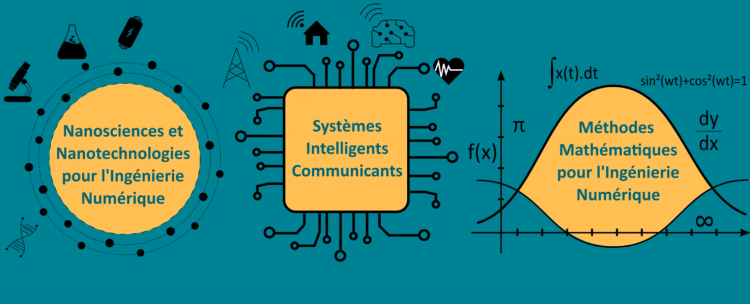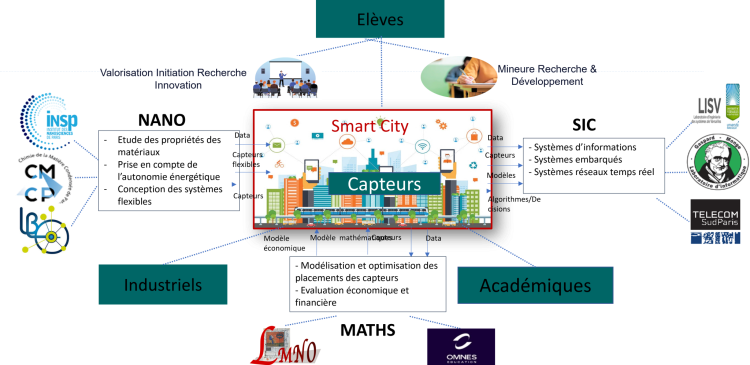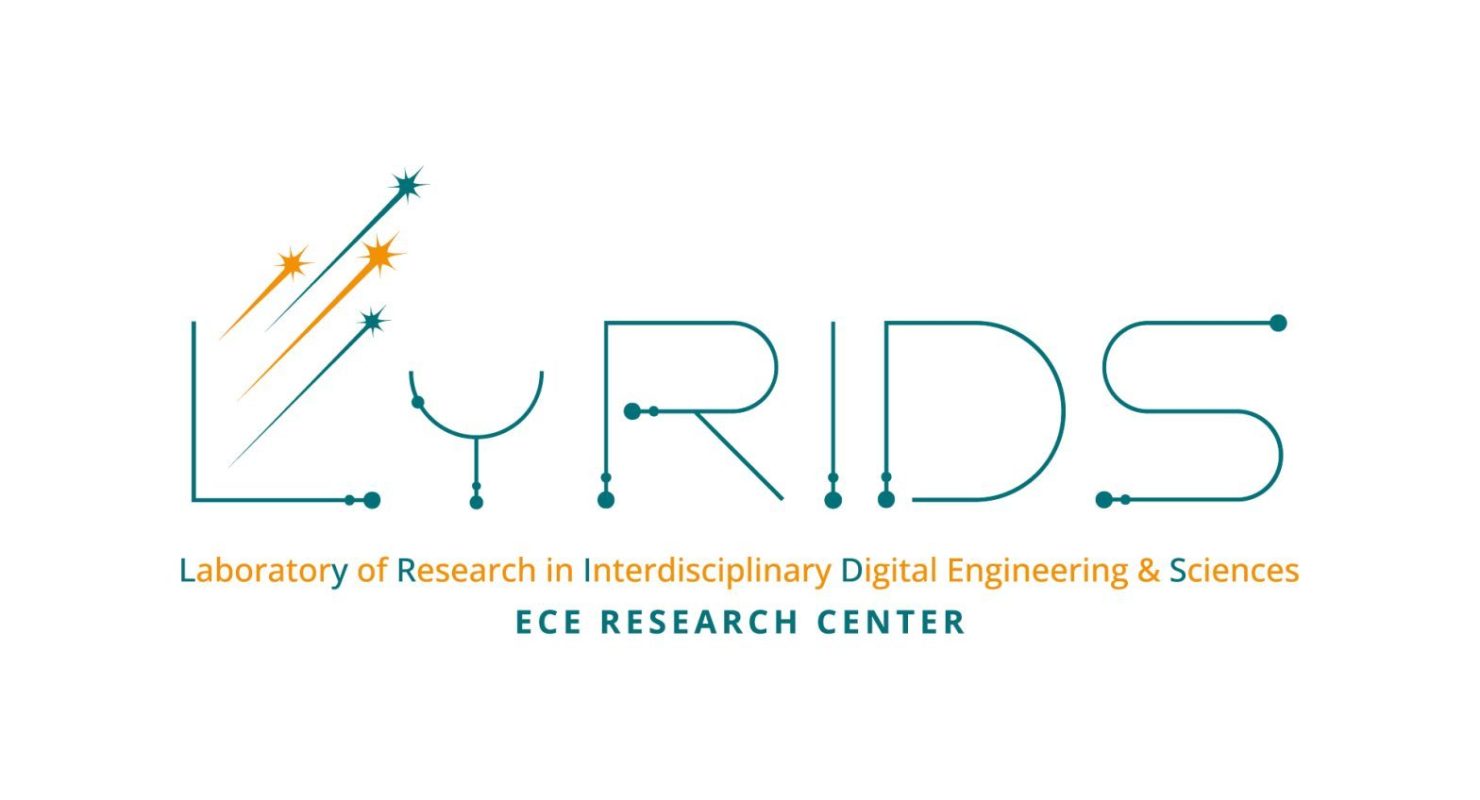Our structuring
LyRIDS – ECE Research Center was founded in 2004. Today, it has about twenty permanent staff and ten doctoral students. It deploys an innovative strategy that enriches the pedagogy and provides students with insight into scientific issues, societal and environmental issues. The research topics of the center cover a wide spectrum of scientific fields including both fundamental and applied aspects. The work is developed in three axes at the confluence of Intelligent Communicating Systems, Mathematical Methods for Scientific & Financial Engineering and Nanosciences & Nanotechnologies.

Scientific activities
The center’s research activities cover a broad spectrum of scientific fields, including both fundamental and applied aspects. Our work focuses on three areas at the crossroads of Intelligent Communicating Systems, Mathematical Methods for Scientific Engineering and Nanosciences & Nanotechnologies. Based on these activities, the interdisciplinary PI-ECE program was set up.

Intelligent Communicating Systems (ICS) division
The development of new Information and Communication Technologies (ICT) is essential. There is a growing international awareness of the need to propose digital solutions to modernize and improve the resources available to people and their environment.
Against this backdrop, the members of the Intelligent Communicating Systems axis launched a first federating project in 2014, focusing on the vehicle of the future. Its aim is to unite permanent members specializing in computer science around a cross-disciplinary project between research themes and ECE majors.
This project falls within the general framework of multimodal interaction in an ambient environment, and within the specific framework of the “vehicle of the future”. It consists of analyzing, designing, developing and evaluating an interactive system with different means of multimodal interaction (input and output).
A great deal of research is already being carried out into the concept of automated driving to bring the car of tomorrow to life: the development of driver assistance systems is one of the best ways of improving road safety.

The aim of this project is to improve the safety of people on board the vehicle and the efficiency of dialogue with on-board electronic systems.
Two approaches are currently being considered:
- the design of hybrid vehicles, offering both automatic and manual control;
- the design of autonomous vehicles, capable of driving themselves without the intervention of a driver.
Ultimately, this intelligent interaction, particularly in urban and suburban areas, enables the car to take account of immediate environmental data, the need (or otherwise) for the driver to react and adapt to a new situation.
The ability to record, anticipate and reduce unpredictable situations is essential, and inherent to the very purpose of the project.
This presupposes an unlimited capacity for learning, in order to accumulate experience and reduce the number of unforeseen situations.
The profile of the members of the SIC axis and their skills have led to the emergence of three research themes in this project:
- Information systems ;
- Embedded systems ;
- Network and real-time systems.
This first cross-disciplinary “vehicle of the future” project and its numerous use cases, such as the semi-autonomous transfer of patients, have enabled us to federate IT skills to produce scientific results.
Nanosciences & Nanotechnologies Axis (NANO)
The axis’ research activities focus on experimental studies for the elaboration (chemical engineering) and controlled properties (physical engineering) of functional nanostructured and flexible materials. Aware of environmental issues, we have chosen to use only soft (aqueous) chemistry, sustainable materials and low-cost approaches. Our research focuses on the characterization, analysis and optimization of nanoscale material assemblies, and their response to external stimuli such as an electric/electromagnetic field or macroscopic mechanical stress. We are focusing our efforts on two themes:
- Functional surfaces and nanostructured thin films.
- Nanostructured multi-hybrid systems.
These two themes are closely interlinked and include both academic and application studies. Due to the nature of the systems of interest and the number of parameters involved, the studies carried out are very time-consuming, and require a wide range of highly technical characterization techniques.

Mathematical Methods for Scientific Engineering (MATHS) division
The objectives of the “Méthodes Mathématiques pour les Sciences d’Ingénieurs” (Mathematical Methods for Engineering Sciences) team are to contribute to the emergence within the School of a dynamic applied mathematics research program on current research topics.
The team’s research will also contribute to developing the teaching of various applied mathematics and scientific computing tools in the curriculum of the Ecole’s engineering students.
The team is organized around two themes classified by mathematical methods whose applications concern engineering sciences and quantitative finance:
- Partial differential equations and optimization
- Modeling dynamic systems using Machine LearninG techniques
In addition, a unifying topic, decided and wanted by the team members, according to their backgrounds and skills, has been defined: “Machine Learning and solving a family of hyperbolic PDEs”.
The scientific backgrounds of the team’s permanent members give the group expertise in a wide range of mathematical, financial and physical fields. All these skills are used to develop a common research topic for the team. We have set up a working group to explore recent work on using artificial intelligence to solve partial differential equations.
The aim of this study is to implement an algorithm for solving a certain family of high-dimensional parabolic PDEs via Deep Learning. The results of this algorithm have already been tested on the non-linear Black-Scholes equation in finance. The aim is to extend this kind of algorithm to other high-dimensional hyperbolic PDEs.
The ECE Interdisciplinary Program (PI-ECE)
The research center’s second mission is to foster the emergence of an interdisciplinary scientific community. In 2018, the center launched an organization around a unifying program named PI-ECE (Programme Interdisciplinaire de l’ECE).
This structuring around an interdisciplinary program enables direct organization to respond in the short and medium term to several use cases in different fields.
The program is part of the general framework of the smart city, which exploits information and communication technologies and the Internet of Things (IoT) to modernize and improve the quality of urban services and resources at the service of people and their environment.
The use of new technologies should make it possible to resolve :
- ecological issues,
- resource conservation,
- the increasing movement of people in cities,
- the construction of more energy-efficient buildings,
- etc.
To meet all these challenges, the city needs relevant, real-time data to make the right decisions.
The design and development of intelligent sensors is therefore essential for optimum environmental control systems.
A number of use cases have already been launched. In particular, this involves the detection and prediction of an operator’s cognitive failure.
The PI-ECE program is nurtured by the skills of the various divisions, which work together to produce concepts and solutions based on this interdisciplinary approach. It is also open to numerous partners (national and industrial organizations) and to ECE students.



